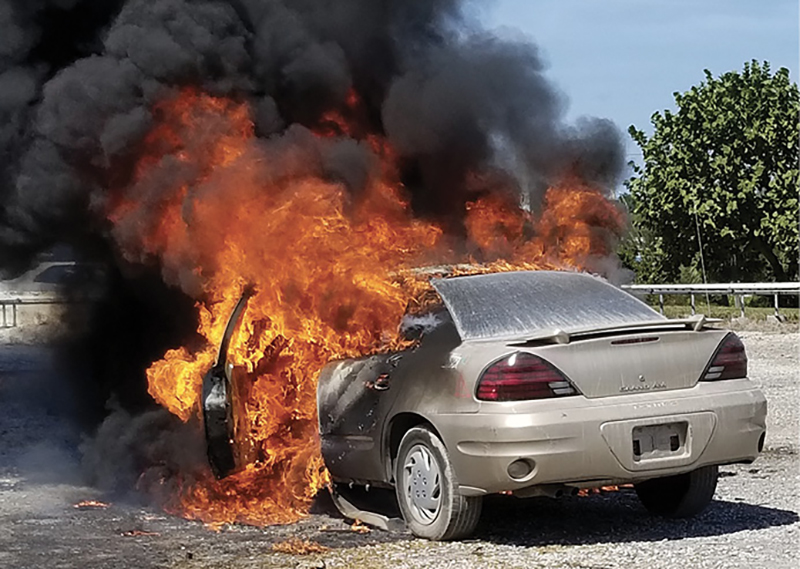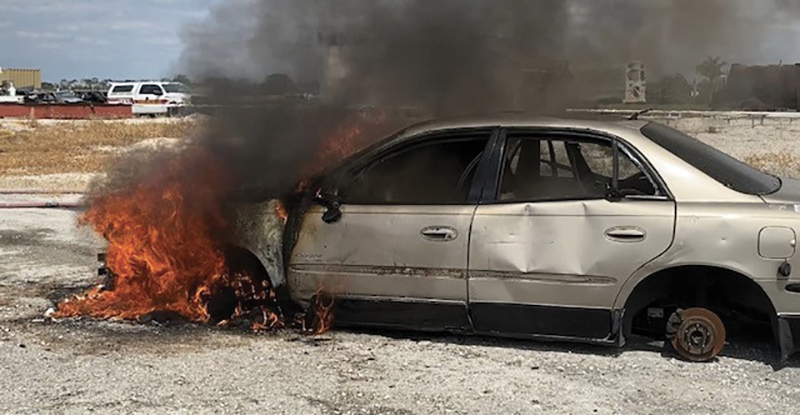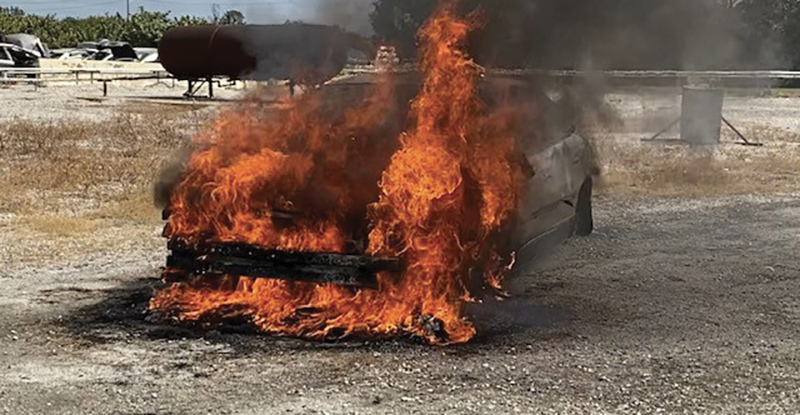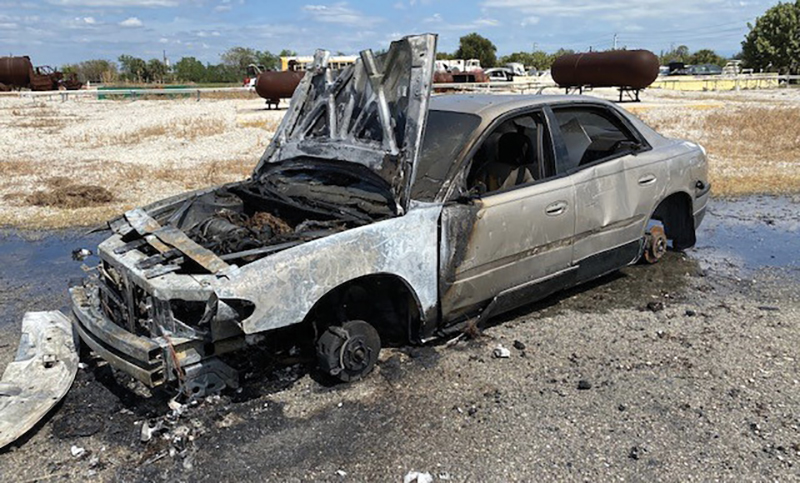In 2019, fire departments across the country responded to approximately 1.3 million fires. Of those fires, 223,000 (17%) were vehicle fires.1 As with structure fires, determining the origin and cause of vehicle fires is left up to paid, volunteer, or public or private sector fire investigators. Because of the quantity of combustible materials in such a small area, a vehicle fire can result in a total loss without many clues left behind to determine the cause. The observations of firefighters and witnesses along with scene preservation may be the only evidence left to help you as the fire investigator to determine the cause.
According to the most recent statistics, arson was the cause of vehicle fires 5% of the time; 23% of the time, fire investigators were unable to determine the cause. Vehicle fires were found to be unintentional (accidental) 38% of the time.2
Vehicle fires burn hot and fast, many times burning away any physical clues. With a total loss, a new fire investigator may be inclined to conclude that the fire was intentionally set (incendiary), but a cause must not be determined until the investigator has examined all evidence.
RELATED FIREFIGHTER TRAINING
- It’s NOT Just Another Vehicle Fire!
- Managing Vehicle Fires Safely
- Vehicle Fires: Is It Time to Change Our Training?
At a vehicle fire, you will gather evidence, including scene and vehicle photographs, physical samples for laboratory analysis, witness statements, vehicle service records, and any recall information. The fire investigator analyzes the data, develops hypotheses, tests the hypotheses, and selects the final hypothesis regarding the origin and cause. At the end of the investigation, there should be no other reasonable hypotheses.3
Since most vehicle fires (83%) involve internal combustion engine passenger vehicles, this article will address those types of fires.2
The Interviews
Witness interviews may provide some of the most important information that the first-arriving crew or law enforcement may gather. First responders can provide key evidence such as the color, the location, and the intensity of the smoke and flames; the vehicle’s condition on arrival; and anything unusual noted at the scene.4 For example, firefighters may state that on arrival they saw flames in the passenger compartment and in the trunk. This could indicate multiple points of origin or may indicate a fire path. A law enforcement officer may arrive first and notice the driver or someone else who was in the vehicle toss something into the bushes.

(1) In this training exercise, the fire was set on the driver’s side in the passenger compartment. Notice how it spread to the engine compartment. [Photo by author; all other photos courtesy of Palm Beach County (FL) Fire and Rescue.]
The vehicle’s condition at time of the first responders’ arrival is also important; it could change significantly by the time the fire investigator arrives. Did the firefighters break the windows or were they already broken? Were the doors, the trunk, or the engine compartments open or closed at the time of arrival? Did the firefighters notice any odd behavior from anyone on scene? Were any obstacles to extinguishment present? Did the first responders notice any unusual odors? 4
Interviewing the vehicle’s owner or driver at the time of the fire is another key investigation component. What events led up to the fire? Was the car having any mechanical or electrical issues? Was any recent service performed on the vehicle? If there is no driver on scene, the fire investigator should speak with the person who reported the fire or any witnesses who may have noticed anything prior to the fire.5
After all interviews are complete, you must look at the physical evidence and compare witness statements to the evidence found on scene.5
The Scene
Once the fire is out, firefighters on scene need to protect, preserve, and secure the fire scene until the fire investigator arrives and maintain scene security until the fire investigator completes the investigation.3
“Firefighters want to make sure they don’t disturb anything on the interior of the vehicle and minimize any damage to the outside of the vehicle after the fire is out,” says Thomas Fucci, captain in charge of fire investigations for Palm Beach County (FL) Fire Rescue.
In his more than 30 years in the fire service and as a certified fire and explosives investigator, Fucci knows all too well the importance of preserving a scene.
At a car fire in Jupiter, Fucci found and collected a cigarette lighter and some paper napkins nearby; DNA evidence on the napkin identified a possible arson suspect. During the interview, the suspect named people who were involved in a double homicide, which was solved because of evidence Fucci found on a vehicle fire scene.
He recommends that firefighters conduct a scene perimeter search and secure any evidence found without disturbing the evidence. If an item of possible evidentiary value is found on scene, such as a lighter, a container of ignitable liquid, or gloves, the firefighter should not touch or move the item but instead should place a cone near it or scene tape around the area to protect the item from damage, tampering, or destruction.
Vehicle owners may be eager to get their possessions out of the vehicle or check to see if an item has been damaged. They will have to wait until the investigation is complete.
The vehicle’s location may be significant to the investigation and can contribute to the hypothesis. Most (75%) vehicle fires occur on highways, on divided highways, on residential streets, in driveways, and in parking areas.6 Finding a car on the side of the highway in the middle of the afternoon with the driver on scene stating smoke and flames were coming from the engine compartment while driving is different from finding an abandoned vehicle fully engulfed in an open field at 3:00 a.m. One situation appears more suspicious than the other, but the investigator can’t make a final hypothesis until all evidence has been gathered and examined.
Since the surrounding area is also included in the investigation, conduct the investigation, if possible, with the vehicle in place where the fire occurred before anything is altered. The investigation includes taking pictures of the scene; any street signs, buildings, highways, footprints, and tire tracks nearby; and collecting any evidence in the surrounding area.3
“I had a car fire a couple of years ago where the car was dumped in a sugar cane field,” says Fucci. “I took several photographs of the scene. One of the photographs captured a cell phone tower which I didn’t realize was nearby. I was able to contact the carrier for that cell phone tower and figure out exactly what phones had pinged off of that tower at the time of the fire. It was really helpful in identifying the suspect, who was later arrested and charged with arson.” This was all because Fucci had captured that cell phone tower in one of his photos.
If the vehicle must be moved, document the scene with photos and collect and document any evidence from the surrounding area before moving it. The investigation of the vehicle can be conducted at the salvage yard.3



(2-4) A fully involved engine compartment training exercise in which the fire was started in the engine compartment. In photo 4, note the burn pattern on the driver’s side door. Firefighters pushed back the hood during extinguishment.
Scene Safety
As with any fire investigation, scene safety must be a priority. You must recognize the hazards of a vehicle fire scene and take all precautions to make the scene as safe as possible. For example, you should chock the vehicle’s wheels since fire damage may cause the brakes to fail. Render undeployed air bags safe so they don’t pose a threat to investigators. Beware of any fuel leaks and leaking lubricants that present slip hazards. Keep intact and cool any compressed gas containers (which may contain propane, hydrogen, natural gas, or other gases) prior to the investigation.3
You must disconnect the battery before the investigation, Fucci says, but finding the battery could pose a challenge in today’s vehicles.
“Manufacturers are now finding other places to put their batteries,” Fucci says. “Several manufacturers now put the batteries in the trunk or cargo area. Mercedes Benz puts the battery under the passenger-side seat, but there are connecting cables and terminal posts inside the engine compartment or in the trunk area that can be disconnected very easily.”
Toxic gases, vapors, and debris in the vehicle remains present a significant danger to the fire investigator; they can remain for hours or even days following extinguishment. Personnel can absorb these toxins through inhalation, dermal exposure, and ingestion. For these reasons, fire investigators must wear appropriate respiratory protection, steel-toe boots with puncture-resistant soles, a disposable protective outer garment, a helmet, eye and hearing protection, and disposable gloves.7
Examination of the Vehicle
You may find the origin of a vehicle fire in three main areas: the engine compartment, the passenger compartment, and the cargo area/trunk.8 The most common areas of origin are the engine area or the running gear or wheel area, which includes the tires, the brakes, and the wheel bearings. Fire spreads more rapidly when an engine has been running, according to research.6
As with structure fires, vehicle fire ignition sources can include arcs, metal sparks, and smoking materials. Ignition sources unique to vehicle fires include the engine exhaust system, the brakes, carburetors, electrical components, and flammable liquids/fuels.3 The most common item to ignite first in a vehicle is electrical wiring insulation (29%); others are tires, cables, trash, liquids, and fabrics.2
Aftermarket items, such as CD/DVD players, amplifiers, and speakers, can cause fires in vehicles if installed improperly. “Most of the good installers will install aftermarket items with inline fuse protection,” says Fucci. “Some of the less reputable installers will just install them without this protection. Unfortunately, they can heat up and lead to significant fires inside the vehicles.”
The leading cause of vehicle fires is mechanical failure or malfunction followed by electrical failure or malfunction. Vehicles that are at least 10 years old are at a greater risk of a fire resulting from these malfunctions.6
Common practice when conducting a fire investigation is to start from the least damaged area and progress to the most damaged area. If the damage is equal throughout, start at one point and work in a left- or right-hand pattern around the vehicle.3
Documenting the vehicle with photos is crucial. Begin by taking photos of the exterior such as windows (note whether they are intact, partially open, cracked, or missing), doors, and burn patterns on the exterior. Remember to include the vehicle’s top and undercarriage.
Sequential photos can help to tell the story. When looking at an area with burn patterns, flame effects, or other evidence, start by taking photos from a distant position. Continue taking photos as you move closer to the object or objects of interest on the vehicle’s exterior and in the interior.3
Once you have taken all the exterior photos, photograph the interior without moving debris or other physical evidence. As with structure fires, you must photograph the area before and after moving any items or debris. When you find physical evidence—e.g., the remains of a gas can inside the passenger compartment—you must photograph the evidence showing its location and position before you remove and secure it.3
While taking photos, notice any clues and begin to informally establish the possible area of origin and the possible cause of the fire. Once this is done, the individual system or systems in that compartment require further examination.3
Look at the position of any switches, handles, and levers. Were they in the on or off position? Was the key in the ignition and, if so, what position was it in? Was the key broken off in the ignition? Note the gear shift’s position.3
Lines of demarcation and other damage may offer clues as to the fire’s origin. For example, when a fire originates in the passenger compartment, the windshield will typically fail at the top and leave burn patterns on the hood that appear to radiate from the compartment. When a fire starts in the engine compartment, the windshield will typically fail at the bottom, and you may see burn patterns on the outside of the doors leading to the passenger compartment.3 Also, engine compartment fires produce large burn patterns on the inside of the hood.8
Evidence will help the fire investigator determine if the fire was accidental or incendiary based on all the evidence and not just one piece. For example, a fuel tank fill cap could be missing because it was destroyed in the fire, or a suspect may have removed it before the fire.3
Helpful Resources
Compare the vehicle involved in the fire to an undamaged one of the same year, make, and model to see what the areas looked like prefire.3
Fucci also recommends conducting a thorough vehicle background check including where it was manufactured and purchased, its service history, and any new keys made for it. The history of a serious defect in the engine is also an important clue, especially if arson is suspected.9
He also suggests reaching out to the insurance company if the vehicle is insured. Because of the Arson Immunity Act, insurance companies must release information related to a fire of suspicious or incendiary origin.
Retrieving the vehicle identification number (VIN) is important to the investigation. The VIN is on the driver’s side of the dashboard or on the driver’s side compliance sticker.8 The VIN will help you find the owner if he is not on scene, and any vehicle recall information. You can enter the VIN in the National Highway Traffic Safety Administration (NHTSA) Web site at www.nhtsa.gov/recalls to discover if there were any recall issues for that specific vehicle.
Finally, remember that bystander photos and videos are also valuable to the investigation.
Putting It All Together
After gathering, analyzing, and researching all the evidence, you, the fire investigator, must determine whether the fire was incendiary (arson) or unintentional (accidental). Did someone have a motive to intentionally set this fire, such as revenge, crime concealment, or insurance fraud? 9
If a vehicle involved in a fire is found to have been stolen, it is highly likely that the fire was incendiary.3 Intentionally set vehicle fires generally originate in the passenger compartment. A key finding will be that the windshield failed and fell inward.8
Were any valuables or was anything else removed from the vehicle, such as personal possessions, CD players, or radios? This suspicious finding may also point to arson.9
Once you have reviewed all the evidence, completed your research, and made a final cause determination, you must write the report.
“The real work begins back when you’re in the office,” says Fucci. “Typically, a car fire investigation is three hours on scene, then another 25 to 30 hours doing the background investigation, so you’re talking almost 40 hours spent on a single car fire.”
Keep in mind that clearly stating your conclusions while supporting them with accurate, factual evidence is only half of the job; ensuring that your report is professional, concise, and well written is the other half. As a fire investigator, you must assume that the report may be used for public safety improvement, to provide the basis for insurance claims, or in lawsuits or criminal prosecutions.3 You must meet this great responsibility with the respect and professionalism it deserves.
References
1. Ahrens, Marty and Evarts, Ben. Fire Loss in the United States During 2019. National Fire Protection Association. September 2020. https://bit.ly/37QwIxf.
2. United States Fire Administration. “Highway Vehicle Fires (2014-2016).” Topical Fire Report Series, 19 (2). July 2018. https://bit.ly/3AOY6rT.
3. National Fire Protection Association. NFPA 921, Guide for Fire and Explosion Investigations (2021 ed.).
4. National Institute of Justice. A Guide for Investigating Fire and Arson. May 31, 2009. https://bit.ly/3ALDTTR.
5. CFItrainer.net. Fundamentals of Interviewing. (Retrieved May 14, 2021). https://bit.ly/3gafAqQ.
6. Ahrens, Marty. Vehicle Fires. National Fire Protection Association. March 2020. https://bit.ly/3iQxnVM.
7. The International Association of Arson Investigators, Inc., Health & Safety Committee. Fire Investigator Health and Safety Best Practices. May 4, 2020. https://bit.ly/3COMFlT.
8. Ivory, Gordon E. What to Look for When Investigating a Vehicle Fire. GEI Professional Investigators LLC. https://bit.ly/37SuxJE. (Retrieved April 12, 2021).
9. Federal Emergency Management Agency. Vehicle Arson—A Combustible Crime. National Arson Awareness Week Media Kit. May 4-10, 2014. https://bit.ly/3iPqEeB.
Connie Pignataro, CFEI, retired from the fire service in 2021 after more than 18 years of service. She served as a lieutenant firefighter/paramedic with Oakland Park (FL) Fire Rescue and later as a fire inspector/investigator for Boynton Beach (FL) Fire Rescue. She has a bachelor of applied science degree in public safety administration.

